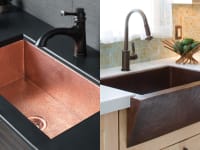Germ-wary homeowners will love these antimicrobial materials
There’s no place like (a germ-free) home
Products are chosen independently by our editors. Purchases made through our links may earn us a commission.
While the pandemic hyper-focused attention on the home as a haven, it also heightened awareness of what is not welcome inside residential interiors—namely bacteria and viruses.
A recent survey of 2,000 individuals by StudyFinds determined more people have become germaphobes in the past two years, leading some to explore the use of alternative building and furnishing materials to foster a cleaner home.
One way to create a germ-free home is to incorporate antimicrobial materials, like quartz and linoleum, throughout. Naturally antimicrobial products "destroy or inhibit" the growth of viruses and pathogens in the home and reduce your dependence and reliance on strong chemical disinfectants, including bleach.
Whether you're mid-renovation or dreaming up your next project, here are five naturally antimicrobial materials that add germ protection to home design.
Metals like silver and copper
Metals that naturally inhibit bacterial growth include silver and copper. Copper is a popular home design material for faucets, handles, and pans. It's a great choice for avoiding germs because it can eliminate 99.9% of bacteria from its surface in less than two hours with regular cleaning.
Copper sinks are particularly appealing for kitchens and baths to provide germ-fighting benefits.
Silver exhibits positively charged silver ions that can kill bacteria, fungi, and certain viruses. But real silver, used primarily in the past to make items such as door handles or knobs, is costly and often difficult to find, except as antiques.
Get the Sinkology Adams 33" Farmhouse Apron Front Sink in Pure Antique Copper at Overstock for $799
Get the Saxon Antique Silver Bed/Bath Door Knob at Home Depot for $17.44
Natural wool fibers
Natural wool is a material frequently found in home goods like carpets. The thin waxy coating of wool fibers comprises fatty acids that inhibit the growth of mold, mildew, and bacteria. The same natural coating repels water that can cause mildew and mold to grow.
Quartz
As Amy Youngblood, principal designer and owner of Cincinnati, Ohio-based Amy Youngblood Interiors, points out, more clients have been wanting quartz, especially for countertops. The man-made engineered stone is formed by combining around 90% ground quartz, which is a natural hard mineral, with a mixture of resins, polymers, and pigments to create a sturdy granite-like surface. Quartz is also used in other household items like coasters.
What makes quartz so resistant to bacteria and other pathogens is chiefly its density. Quartz is an extremely firm and nonporous material, rendering it naturally antimicrobial. Without a place to thrive, the germs have no habitat.
Linoleum
Real linoleum (versus synthetic versions or vinyl), is made from all-natural materials such as ground limestone, powdered cork, jute, and linseed oil—all of which are found to have antimicrobial properties.
A 2015 study published in the National Library of Medicine found cork to be highly resistant to the bacteria responsible for staph infections. Cork is also water-resistant, making it a prime choice for establishing a germ-resistant kitchen because water can trap moisture and become an ideal environment for germs. Linoleum is also used in flooring.
Get the Forbo Marmoleum Splash at Green Building Supply for $4.91 per square foot
Bamboo
Bamboo is a naturally antimicrobial material commonly found in home products like serving bowls, cutting boards, and bedding. Though Bamboo is a hard material in the wild, it can be manufactured down into ultra-soft sheets, duvet covers, mattresses, pillows, and pillowcases that offer antimicrobial and cooling capabilities.
Woods, in general, also dry quickly, making it more difficult for bacteria to grow. That is why cutting boards are made from materials like bamboo, teak, maple, walnut, cherry, beech, and more. Some of these woods make ideal choices for kitchen island tops, flooring, and bath mats.
Get the Cathrine Rectangle Teak & Wood Non-Slip Shower mat at Wayfair for $135.99
Get the Winston Porter Carlijn kitchen cart at Wayfair for $209.99
While sometimes more expensive than man-made counterparts, natural antimicrobial-inherent materials often convey more value because they tend to be higher achievers regarding performance and longevity. They also give users health and environment-related peace of mind that artificial options may not.
The product experts at Reviewed have all your shopping needs covered. Follow Reviewed on Facebook, Twitter, Instagram, TikTok, or Flipboard for the latest deals, product reviews, and more.
Prices were accurate at the time this article was published but may change over time.


